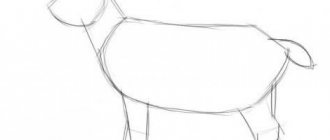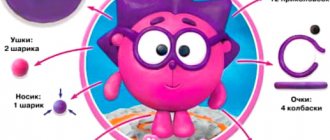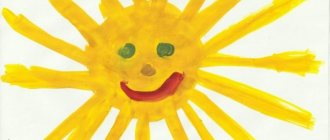Progress of the lesson
Introductory part (surprise moment)
(audio file with a baby crying is turned on)
The girl Masha is part of .
She's crying. The teacher draws the children's attention to Masha. Encouraging them to say hello to her. Masha: - Today the cat Vaska ate my favorite fish . And I felt very sad without her.
Educator: - Guys, let's help Masha. Let's draw a fish so that it doesn't feel sad. fish did you have ?
Educator: What color?
The teacher places images of aquarium fish , including goldfish, one .
Educator: - That's right! They float in the water. They need water to live. Do you think the fish see us ?
Finger gymnastics " Fish " arr. N. V. Nishchevoy
The fish swims in the water , the fish have fun playing .
(With their palms folded together, children depict how a fish )
Fish , fish , mischief, (They shake a finger)
We want to catch you. (Slowly bring palms )
The fish arched its back , (Again they depict how the fish )
I took a bread crumb. (Make grasping movements with both hands)
The fish waved its tail , the fish swam away again (hide the hands)
.
Educator: - This is not an ordinary fish house, but a glass one. Let's repeat the name of the house - aquarium (children repeat in chorus and several answers individually)
.
Only it's empty. Let us draw a fish so that she doesn’t cry anymore.
The teacher shows the children what he will do. his palm in the paint and applies it to the template, after which an imprint remains on the sheet. After this, he asks the children to repeat the same actions themselves.
Or he paints the child’s palm himself if this causes difficulty for the child. In this case, the fingers can be spread out or pressed, both options are possible.
Then children dip their finger in the paint and use dotted movements to make paint marks on the bottom of the aquarium . After each change of paint, wipe your palms with napkins .
Educator: - While the fish , we will play.
The fish swim in the water (make smooth (wavy)
hand movements);
Fishes have fun playing . They will clench and unclench (The hands clench into fists and unclench with their fingers outstretched)
;
Then they will bury themselves in the sand (Imitation of hands digging in the sand)
.
Final part (Reflection)
Summary of the GCD for drawing with palms in the second junior group “Autumn Tree” Drawing with palms is a very interesting and spectacular process, both for children and adults. When we draw with our palms, the work comes into play.
Summary of a lesson on applique from natural material “Goldfish” for children of the first junior group Educational area “Artistic and aesthetic development” Goal. Development of children's creative potential. Formation of ability to work.
Notes for a drawing lesson “Track for an engine” in the first junior group LESSONS FOR A DRAWING CLASSES “WAY FOR AN ENGINE” IN THE FIRST YOUNGER GROUP Notes for a drawing lesson for the first younger group. Notes for a drawing lesson “Matryoshka” in the first junior group SUMMARY OF DRAWING CLASSES “MATROSHKA” IN THE FIRST YOUNGER GROUP, Materials and equipment: Matryoshka toy, prepared. Summary of a drawing lesson in the first junior group “Puddles” Purpose: to train children in drawing a continuous rounded line, using a brush to paint the surface without going beyond the boundaries. Objectives: Educational:. Summary of a drawing lesson in the first junior group “Amanita” Goal: to expand and clarify children’s knowledge about mushrooms. Introduction to the technique of drawing with cotton swabs. Objectives: Educational: continue.
Preview:
MKDOU KINDERGARTEN OF COMPENSATING TYPE
Lesson notes on use
non-traditional drawing methods in the younger group.
Kolomna urban district
Educational areas: social - communicative, cognitive, artistic - aesthetic.
Examination of illustrations, pictures depicting fish and aquariums; observing fish in a large aquarium in a kindergarten.
A large sheet of whatman paper with an image of an aquarium, brushes, gouache paints in primary colors, wet wipes, two basins for clean and dirty wipes, a beautiful bag (for a brush), jars of water, a large doll toy, rubber toys, for choice: fish of different colors and sizes, cat, ball, dog; inflatable mini-pool with water.
Fish(t), fish(t), paint(t), water(t), brush(t), hello(t), sit(t), give(t), doll(t).
At the signal of the drum, the children approach the teacher. The teacher invites the children to sit on chairs.
1) The teacher draws the children’s attention to the table, on which there is a jar of water and a saucer of paint hidden under a napkin.
The teacher invites one child to look under the napkin and choose a sign indicating paint (choice from two signs).
If the child chooses the correct sign, praise the child and open the napkin. Otherwise, invite another child to look under the napkin and choose a sign.
2) Clarify with the children that there is water in the jar (choose a sign). Draw the children's attention that there are a lot of jars of water and saucers of paints on the children's desk.
If the child chose the sign correctly, then take out all the brushes and offer the other children the sign to choose from.
If the child makes a mistake, then the next child feels the brush.
In the process of selecting signs, the doll moves the brush over the children’s palms to allow them to feel the softness of the brush.
4) Then the teacher shows the children and the doll Masha what can be done with a brush and paint: he paints his palm with paint using a brush and makes an imprint on the paper, puts a black dot-eye with his finger. Shows it to the children.
5) The teacher invites the children to make the same prints on a large sheet of whatman paper. Children ask the doll for brushes, the doll hands out brushes, and the children thank them.
Then the children go to the work table and begin to paint their palms with paint. The teacher and nanny help to take the brush correctly and apply the paint evenly. The doll sits on a chair and looks.
Having painted their palm, the children make an imprint on whatman paper where the aquarium is drawn. The teacher or nanny quickly wipes the children’s palms with wet wipes.
5) Having examined the finished drawing, the children look for a similar object in the group. Having found an aquarium, clarify with the children by choosing the desired toy and a sign (choice of two) that there are fish in the aquarium.
Invite children to put fish toys into an inflatable pool of water and blow on them so that they float.
Source
Summary of the lesson on drawing with palms “Fun Aquarium”
Tatyana Gordeeva
Summary of the lesson on drawing with palms “Fun Aquarium”
Hello dear colleagues! Today I would like to present to your attention the painting with palms “ Fun Aquarium ”
An aquarium with small fish is the dream of most kids! Someone already has them. and someone really wants it. For those guys who don't have fish at home, we decided to draw !
Goal: getting to know a new way of drawing .
Integration of educational areas: cognitive development, artistic and aesthetic, speech.
— Give an idea of a new way of drawing .
— Develop artistic and aesthetic taste (combination of colors, sense of composition)
;
- Develop children's creativity and imagination.
Materials and equipment:
— A4 album sheets





